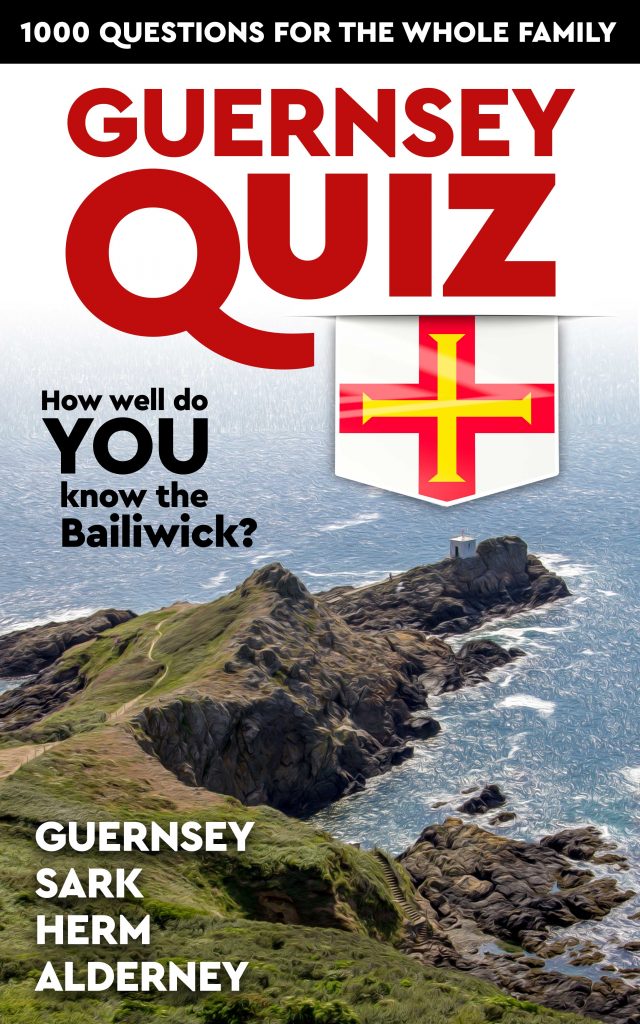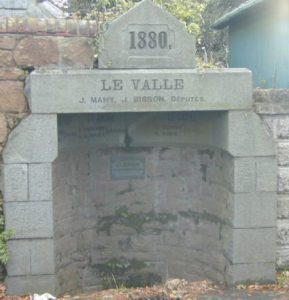
Test your knowledge with these 20 questions we’ve gathered from Lukas Aleksandr’s excellent book “Guernsey Quiz Book : 1000 questions for the whole family”.
We’ve assigned our own made up rating system, below, for your score … enjoy ! 🙂
| Ratings | ||
| 20 correct | ………… | Super Sarnian ! |
| 15-19 correct | ………… | Splendid Sarnian |
| 11-14 correct | ………… | ‘Satisfactory Sarnian’ (but some work needed) |
| 6-10 correct | ………… | ‘Sub-Standard Sarnian’ (some serious work needed) |
| 0-5 correct | ………… | You must be from Jersey! |
<b>(1) What is an abreuvoir, commonly found throughout Guernsey?</b> |
<b>(2) In which year did the occupying forces introduce driving on the right to Guernsey’s roads?</b>
1941 In addition to changing the rules of the road the German Occupying authorities changed the Channel Island time zone from GMT to CET to bring the islands into line with most of continental Europe. |
<b>(3) To what animal, a pet of the tenant Sir Percival Perry, is there a monument close to the White House Hotel on Herm?</b>
A parrot, which was strangled by drunk fishermen. Percival Lea Dewhurst Perry, 1st Baron Perry KBE (18 March 1878 – 17 June 1956) was an English motor vehicle manufacturer who served as chairman of Ford Motor Company Limited in Britain for 20 years from its incorporation in 1928, completing almost a lifetime’s work with Henry Ford. In 1922 he retired to live mostly on Herm where he wrote, with his wife The Island of Enchantment published in 1926 |
<b>(4) What appears on the back of any Guernsey penny produced after 1985?</b>
A crab
You can read more about Guernsey’s own Currency in our article entitled Beating the Bankers at their Own Game – the Guernsey Way. |
<b>(5) If inspectors came to your home for a 'Visite du Branchage', what would they examine?</b>
Foliage on your property. They will be looking for bracches overhanging paths and roads
The vist is conducted by Douzaineers, members of the main ‘council style body’ in each parish. As the name implies the Douzaine, is usually made up of twelve members although there are exceptions, the Vale having sixteen and St Peter Port having twenty. |
<b>(6) Which monarch was wearing white stockings from Guernsey for her execution in 1587?</b>
Mary Queen of Scots The knitting industry in Guernsey today is all but extinct. However there was a time when it used to be quite a sizable proportion of her GDP with the majority of her population involved in it in some way or another, both women and men. All kinds of goods were being produced : undergarments; waistcoats; gloves; stockings and of course the famous seaman’s knitted woollen sweater ‘the Guernsey’. One of these garments was famously being worn by Mary Queen of Scots when she was executed on the orders of her cousin Queen Eliazabeth I. You can read more about this in in our article The Knitting Industry in Guernsey. |
<b>(7) To which saint is Vale Church dedicated?</b>
St Michael The full official name of the church is ‘St. Michel du Valle’ and was originally linked to Mont Saint-Michel monastery in Normandy.
The last remaining stonework from the original building is a piece of buttressed wall to the South of the church, by the roadside. |
<b>(8) When was Guernsey Football Club founded?</b>
2011, their first season was 2011-12.
Over the course of 2011, the club’s founding directors, Steve Dewsnip and Mark Le Tissier, received encouragement from the Football Association, the Guernsey FA, the Combined Counties League (which we were introduced to by the FA), the clubs then main sponsor Sportingbet, the States of Guernsey and the island’s local football community to take pland for the club further. The rest is history. |
<b>(9) How did French nuclear physicist Andre Gardes come to prominence in August 1990?</b>
He attempted to invade Sark, armed with a semi-automatic weapon
The invasion was ‘crushed’ when Sark’s Constable, after asking to see the gun he was loading, punched Gardes on the nose. The gun used in the attempted coup now sits in the Sark Museum next to old ships and a dedicated exhibit to one of the island’s two original telephone calls. |
<b>(10) The full name of St Andrew’s Parish Church is “Ecclesia Sancti Andreae de Pendente Pomeria”. What does that mean?</b>
St Andrew of the Sloping Apple Orchard
|
<b>(11) How did John Tapner come to prominence in February 1854?</b>
He was the last person executed on Guernsey Tapner, who was English, was living in St Martins when 74-year-old Elizabeth Saujon was murdered in her home in St Peter Port on 18 October 1853. Saujon had been knocked unconscious and left to die in her burning house. Tapner was arrested and tried for the murder of Saujon. At the trial, it was revealed that Tapner’s mistress — who was his wife’s sister — lived with Saujon. There were also reports of some of Saujon’s belongings being discovered near Tapner’s house in St Martins. While Tapner admitted to being in St Peter Port the evening of the murder, he denied any involvement in the fire or Saujon’s death. It was never clear what Tapner’s motive would have been for killing Saujon and burning down her house. Tapner was convicted of murder by the Jurats and sentenced to death by hanging. Victor Hugo (who would later move to Guernsey) and 600 residents petitioned the Home Secretary of the United Kingdom, Lord Palmerston, to commute Tapner’s sentence. However Palmerston refused, and Tapner was hanged on 10th February 1854 in St Peter Port. His execution was unfortunately botched and instead of a clean death Tapner died of strangulation. No one was executed by Guernsey after Tapner’s execution. Guernsey abolished the death penalty in 2003. |
<b>(12) Which of the following is St Sampson, Guernsey’s patron saint, not said to have banished from the island: serpents, frogs, moles, toads?</b>
Frogs
You can read more about Saint Sampson in our article Saint Sampson and the Christianisation of Guernsey. |
<b>(13) What name was given to the 3rd century Roman shipwreck found in the mouth of St Peter Port harbour in 1982?</b>
Asterix
By coincidence, a Roman waterfront site at La Plaiderie was excavated by Bob Burns of Guernsey Museum during the same period. Until this double find, there was very little to indicate that the Romans even came to Guernsey. Between 1984 and 1986, archaeologists led by Dr Margaret Rule teamed up with local divers to excavate the ship and it was during this time that a schoolboy watching the diving asked whether this was ‘Asterix’s ship’ and so the name stuck and the ship became known locally as ‘Asterix’. You can read more in our article entitled Asterix – Guernsey’s Own Roman Wreck. |
<b>(14) Who wrote 'The Guernsey Literary and Potato Peel Pie Society' ?</b>
Mary Ann Shaffer and Annie Barrows The Guernsey Literary and Potato Peel Pie Society has put Guernsey truely on the map, at least for certain middle-aged American women, who have taken the book to their hearts. American vistors often come to the island simply to view the loacations where the book is set. If you’re curious about the book (& the recipe) then you can try it out in our article entitled The Guernsey Literary and Potato Peel Pie Society – The Recipe. |
<b>(15) From which European country were tomato plants first brought to Guernsey?</b>
Spain Just when the tomato first arrived in Guernsey is unknown. The tomato was brought to Europe in the 1500s but was only grown as a decorative plant as the fruit was believed to be poisonous. Around 1864 an English newspaper published a story claiming research had shown the tomato was not only edible, but had health benefits. Only a year later, in 1865 a few growers were already exporting tomatoes. By the 1870s the tomato was being grown commercially on the island, soon replacing the more traditional vine in many Guernsey glasshouses. You can find out more about the once famous Guernsey Tomatoe Indutsry in our article entitled The Guernsey Tom. |
<b>(16) What does the Old Norse “-hou” at the end of Lihou and Brecqhou mean?</b>
A small hill or mound That said, its etymology and meaning are often disputed, with some specialists thinking that it comes from Saxon or Anglo-Saxon hōh “heel”, sometimes hō, then “heel-shaped promontory”, “rocky steep slope”, “steep shore”. However as it can be found everywhere in Normandy, especially in the western part of it, its norse origins are more favoured locally. |
<b>(17) Which island in the Bailiwick of Guernsey provided the granite for the steps of St Paul’s Cathedral in London?</b>
Crevichon
The streets of London are literally paved in Guernsey granite. One of the largest quarry owners in Guernsey in the nineteenth century was John Mowlem, who won the contract to repave Blackfriars Bridge, the Strand and the Thames Embankment. |
<b>(18) Which famous actor recounted tales of the wartime raids on the Channel Islands on which he took part, in his autobiography, The Moon’s a Balloon?</b>
David Niven
Much of the details of the raid were worked out by David Niven, who was then serving as a staff officer in the Combined Operations Headquarters. |
<b>(19) What was used as a table on HMS Bulldog for the signing of the terms of Germany’s surrender of the Channel Islands in 1945?</b>
A rum barrel
|
<b>(20) How long did Queen Victoria and Prince Albert’s 1846 visit to Guernsey last?</b>
Only Two hours
A small granite stone was laid to mark where the queen had first stepped ashore in St Peter Port harbour and the following year, despite the brevity of the visit, the Guernsey people determined to errected St Peter Port’s Victoria Tower. |
The questions above have been reproduced, with kind permission, from Lukas Aleksandr’s book “Guernsey Quiz Book : 1000 questions for the whole family”. If you want to get your hands on the full 1,000 questions then it’s available from Amazon

















